The Samsung Galaxy Note5 and Galaxy S6 edge+ Review
by Joshua Ho on October 2, 2015 8:00 AM ESTSystem Performance Cont'd
Now that we’ve covered some of the traditionally CPU-bound tests, we can start to look at tests that more strongly emphasize GPU performance. It’s worth noting here that while 3DMark is supposed to determine gaming and graphics performance, the overall score includes a CPU performance component in the form of a physics test that means it isn't much of a pure GPU test.
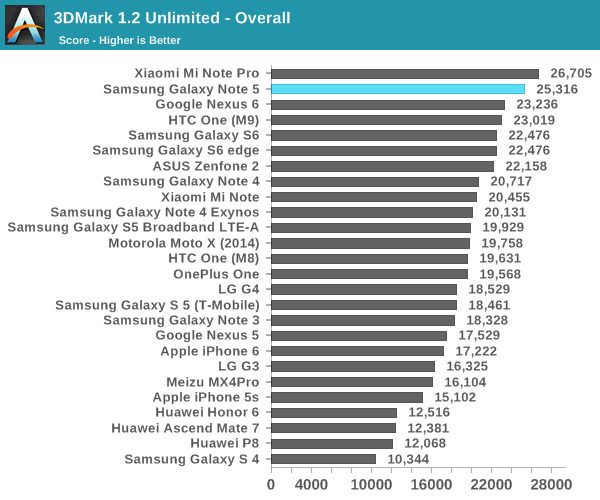
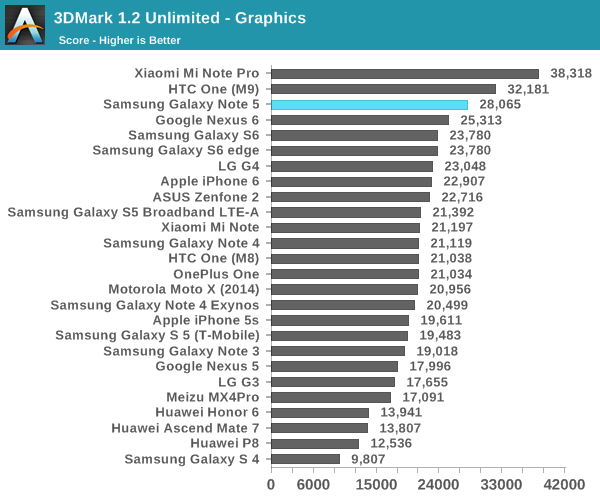
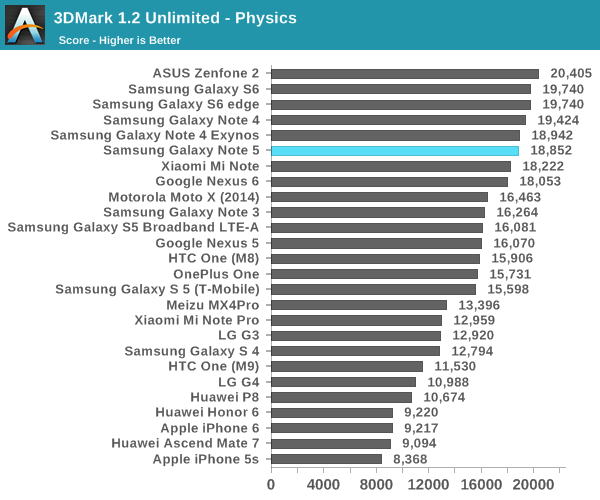

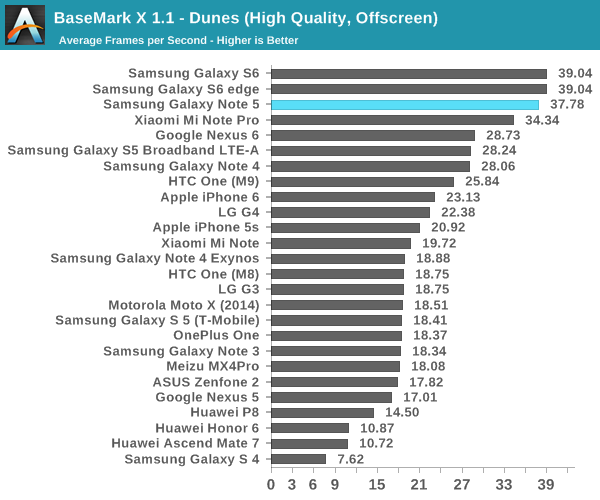
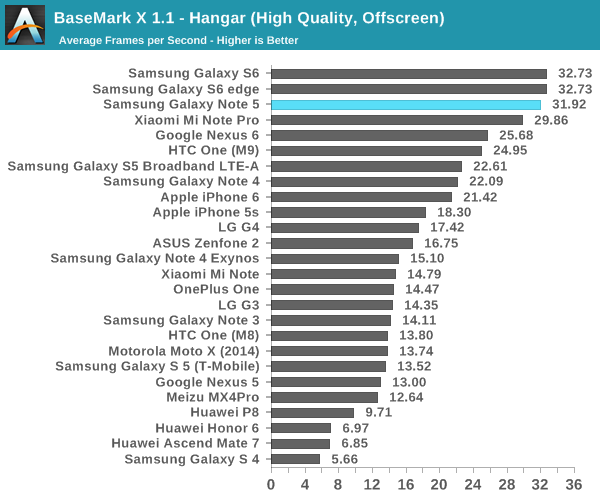
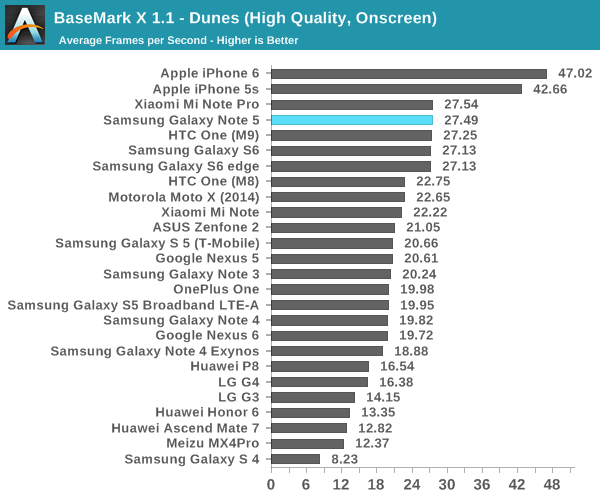
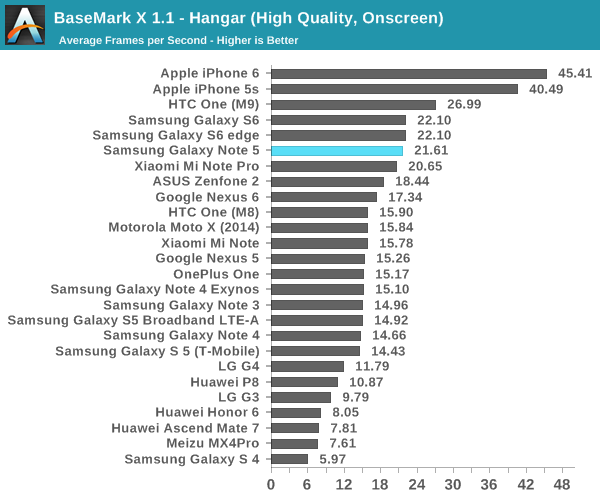
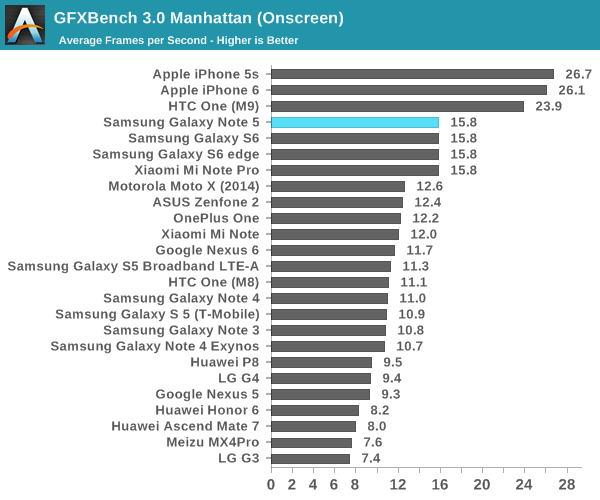
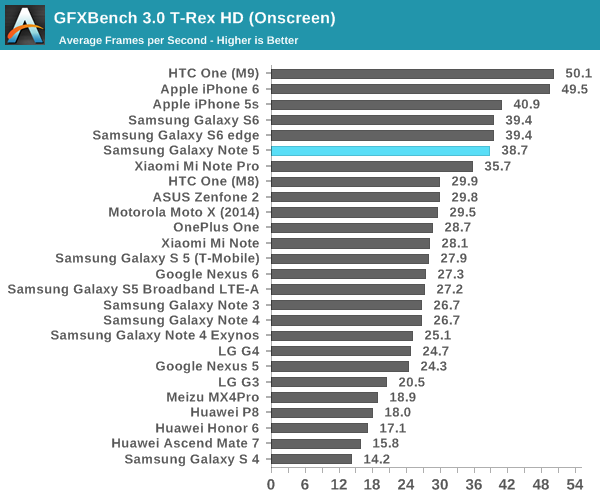
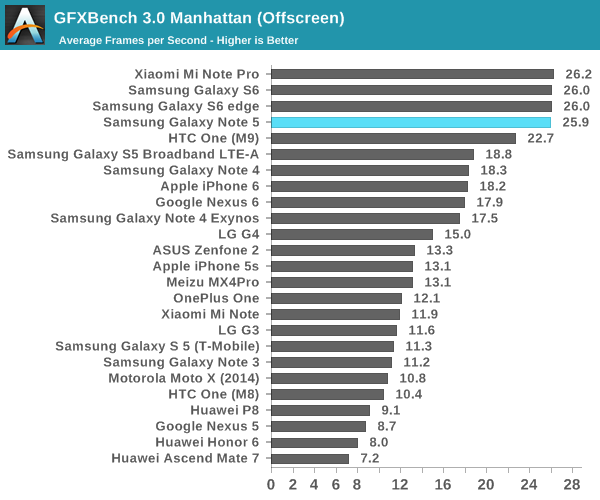
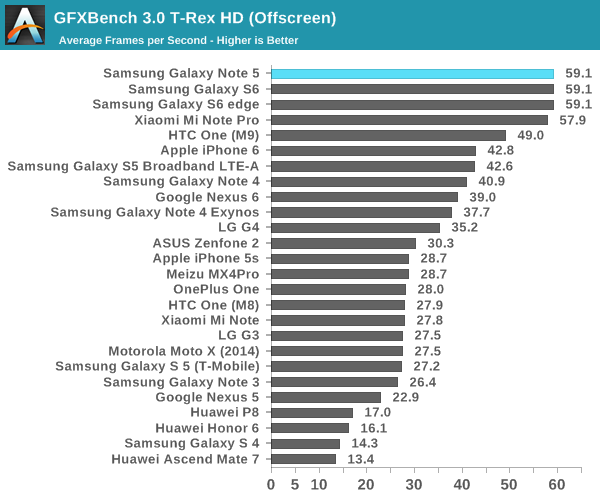
Overall, there's nothing really surprising about these results. The Exynos 7420 should continue to deliver great GPU performance for anyone interested in a high-end phablet or smartphone. There are some improvements in 3DMark in regards to graphics performance, but it's likely that we're just looking at newer drivers as the GPU doesn't heat up fast enough for throttling to be affecting these results.
NAND Performance
At this point, it’s probably not a surprise to know that NAND performance can have very real effects on user experience. If an OEM decides to skimp heavily on storage in order to drive the price down, it’s at least somewhat likely that the device will start to exhibit major IO pauses at some point in the device lifecycle. In order to test this, we rely on our standard storage tests which include Androbench with some custom settings to get more realistic test results along with StorageBench for iOS which is comparable to Androbench.
In the case of the Galaxy Note5 we’re still looking at a UFS storage solution similar to what was found in the Galaxy S6, but it looks like this is slightly newer as the storage is identified as a Toshiba THGLF2G8J4LBATDA chip rather than the Samsung variant that was found in the Galaxy S6. It’s unclear whether Samsung is now multi-sourcing UFS storage for their mobile devices or what distribution exists here.
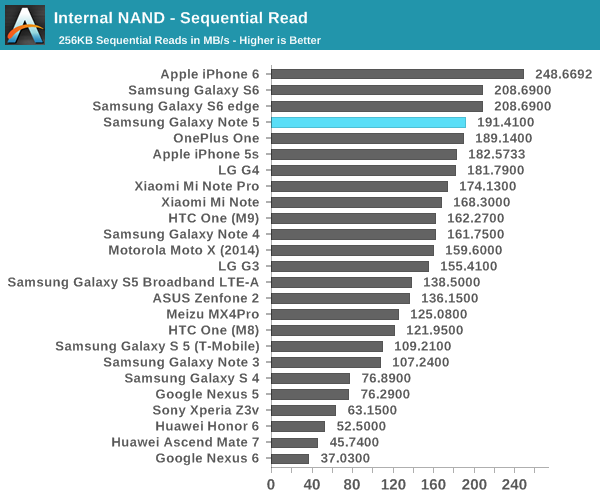
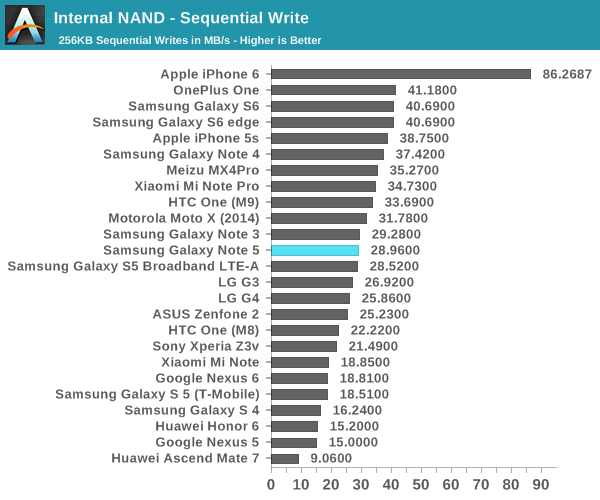
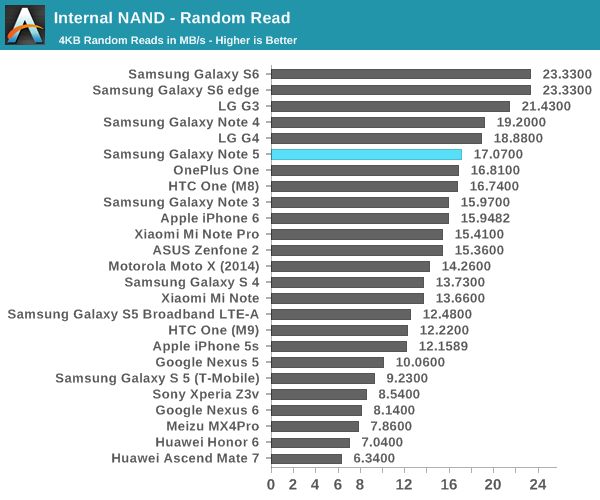
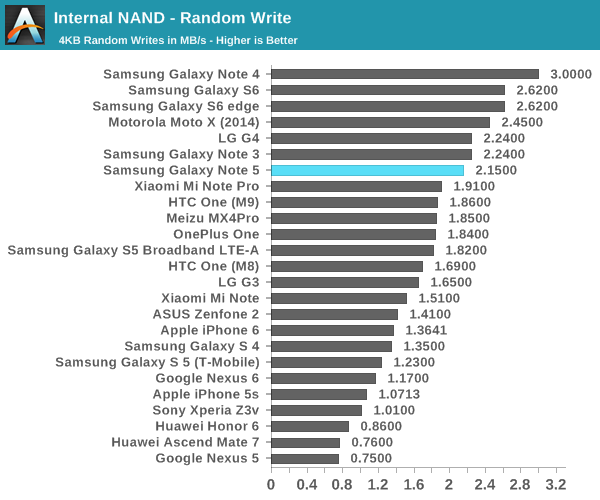
Interestingly, the Note5 regresses a little bit in storage performance relative to the Galaxy S6, which is likely due to the shift to Toshiba's NAND. However, this difference is small enough that in everyday use it's unlikely that it will be noticed. Performance over time should be acceptable as well.










225 Comments
View All Comments
thedons1983 - Sunday, October 18, 2015 - link
Apple genius = regular retard. Those morons don't have a clue. I know more about iOS, than those idiots. Customer service does not equal customer satisfaction. Especially when the idevice in question breaks every few minutes.hrrmph - Sunday, October 4, 2015 - link
Nice review that hits most of the major points, but I would like to see a few more things returned to AT's reviews:- Audio performance (for many people, a phone is their primary audio source, so quality counts);
- Battery configuration (not to push the discussion one way or the other, just remind us whether it does or doesn't have a removable battery.);
- More on storage (considering AT's roots as a PC website, and smartphones' inexorable drive to eventually replace PCs, a wider discussion of storage is needed. Especially with phone cameras recording 4K and everyone's storage needs going up in formation, it is important to discuss how to store things on the device and how to offload them from the device. This issue is dogging Apple, Google, and Samsung, all of whom have now eschewed internal removable storage, without stating when they will develop a replacement, if ever.).
----------------
I would also like to see something added to AT's phone reviews:
- How to control audio playback without looking at the phone (particularly Play, Skip Forward to Next Song, and Skip Back to Previous Song, and Mute. Blackberry nailed most of this with their very helpful physical button configuration, and thus when driving in a car and playing music, I cannot be without a Blackberry. What are Apple, Google, Samsung and the others doing for audio control while driving... without having to buy a new car, that is. Is voice control the only way, and if so does it work well.)
SydneyBlue120d - Sunday, October 4, 2015 - link
Any info about the HEVC encoding? We know the SOC support it, however there is no way to use it, I think this relate to the HEVC licensing knightmare, do You think we will ever be able to use it? Maybe using some third parts app? Thanks a lot.kogaharukka - Sunday, October 4, 2015 - link
For Nand performance, please check it with Androbench v.4.0.The numbers from Androbench v.3.6 cannot show real Nand performance.
SnowleopardPC - Sunday, October 4, 2015 - link
My biggest issues with these phones are that Samsung surveyed Iphone users about what features they wanted in their next phone and of course the Isheep said nothing about Micro SD Card slots and changeable batteries.I went with Samsung because I want my 10,000 MAH extended battery and 200gb MicroSDXC card from Sandisk.
Now all Samsung makes is a cheap IPhone that runs anroid.
And the 128gb version was an after though and "might" be released in the next 2 months, and it still will be missing a micro SDXC card slot and have a low powered worthless battery......
thedons1983 - Sunday, October 18, 2015 - link
You are an idiot. Pure and simple. What a loser. Benchmarks are for idiots.coolhardware - Sunday, October 4, 2015 - link
As per the Kuzi's earlier comment:+the S6/Edge/Note 5 resolution of 2560x1140 = 3,686,400 pixels
+iPhone 6S Plus is 1920x1080 = 2,073,600 pixels.
A fewquestions: #1 how do these screens look next to each? (is there a noticeable quality difference)
#2 how much of a battery/performance penalty is there for Samsung? (are they competitive despite handling way more pixels, or do they suffer for it)
#3 how bright do the Samsung's get on "auto" b/c my S6 is visible in any sunlight conditions when in that mode, are the latest iPhone's also able to be viewed easily in full sun?
Lastly, why do AMOLED displays have difficulty with the "painted on" effect vs. LCDs? I notice that my wife's Moto X Pure's LCD looks crisper and more "painted on" than my S6.
PS thanks for the great review as always!
PSS For reference on the first questions, here are iPhone pixel densities: http://pixensity.com/search/?search=iphone
and Samsung Galaxy pixel densities: http://pixensity.com/search/?search=samsung%20gala...
Kuzi - Monday, October 5, 2015 - link
Thanks for the site showing the resolution and PPI for devices.To answer #2, Samsung have been improving/reducing the power draw of their AMOLED panels with each generation. So even while pushing such high resolutions the penalty is minimal, especially when compared to LCD technology.
For #3, you can check below and "Expand" the results to show more phones for the Sunlight Visibility test:
http://www.gsmarena.com/apple_iphone_6s-review-131...
ciderrules - Monday, October 5, 2015 - link
The power consumption for the higher resolution isn't just the display and technology. It's the GPU power required to drive that display. It takes more processing power to drive more pixels. Especially if you want day-to-day activities to be smooth (like scrolling).Kuzi - Tuesday, October 6, 2015 - link
The Galaxy S6 is getting 73 hours battery endurance rating:http://www.gsmarena.com/samsung_galaxy_s6-review-1...
iPhone S6 is getting 62 hours:
http://www.gsmarena.com/apple_iphone_6s-review-131...
So even though the Galaxy S6 is pushing 3.6 times more pixels compared to iPhone 6S it doesn't seem like the battery perfomance is suffering.
And the GPU doesn't run at high frequencies when web browsing or playing videos. Although for 3D games the battery will get drained faster with higher res screens for sure.